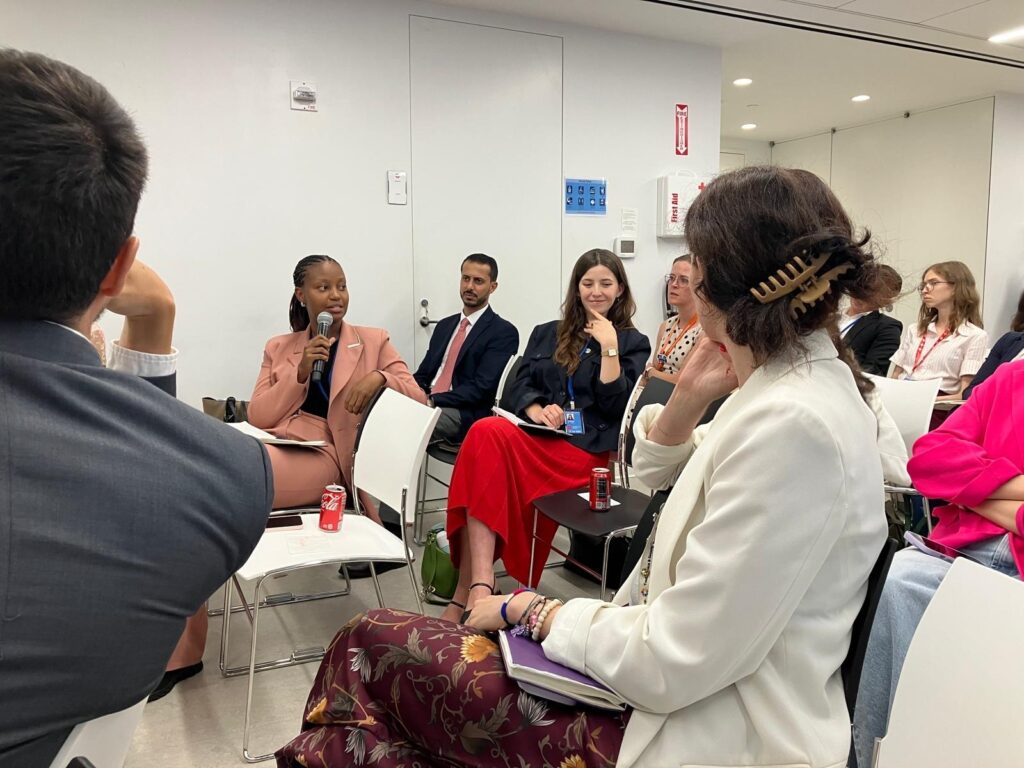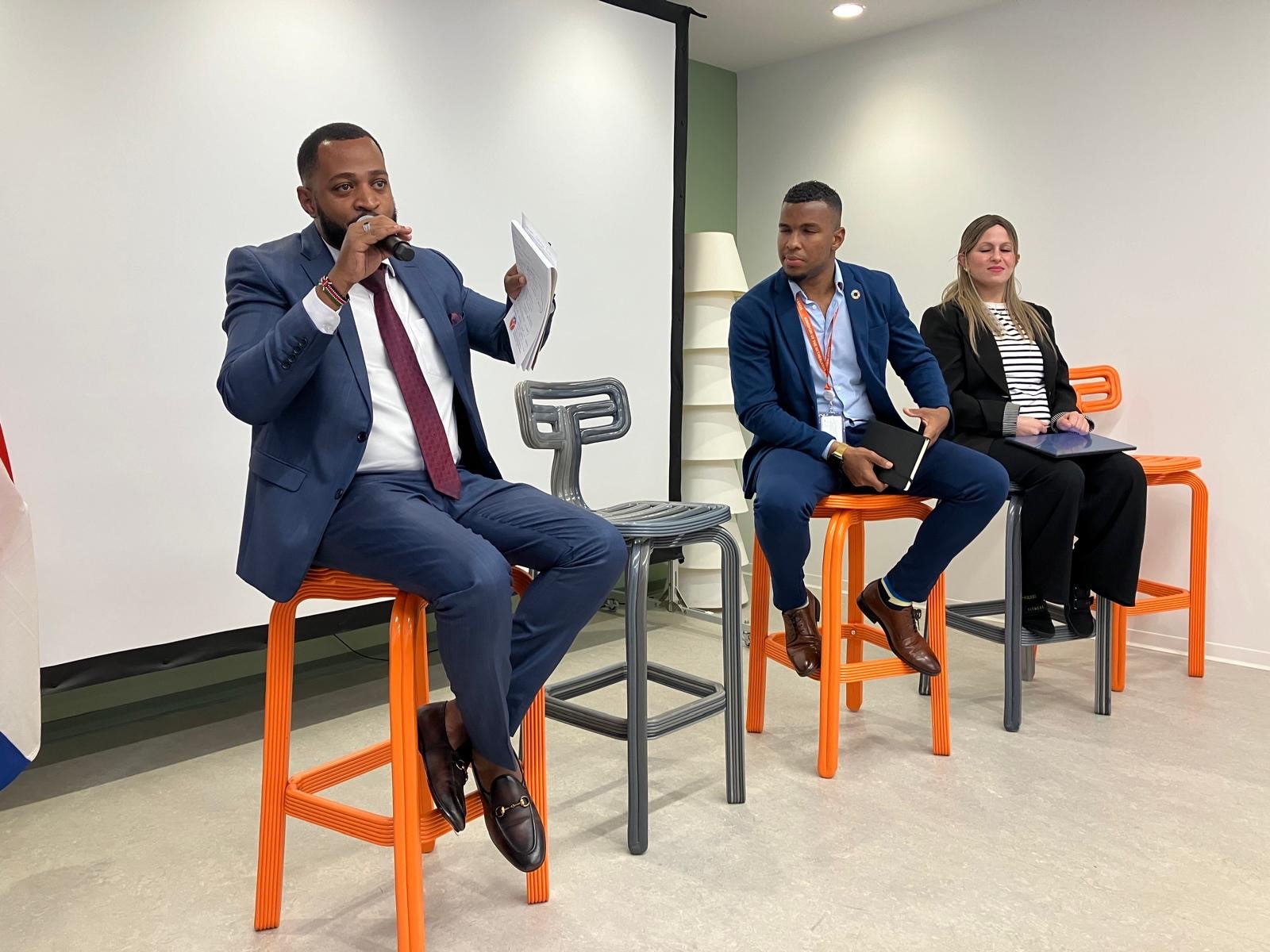The Voice of Youth at the Table in the Big Apple

Stretching the letters on the page, the Voice of Youth at the Table report woke from its slumber; it was an exciting day. It was the day – the launch, in New York, no less. Today, it would show the world what it had to offer – a compilation of lessons learned, stories, and collective challenges that its writers had faced in their work on youth political participation worldwide. Together with its writers, it would present its findings at the Permanent Representation of the Kingdom of the Netherlands to the United Nations (UN) with an audience of (youth) representatives from multiple countries, UN officials, youth delegates and organizations working on youth political participation. Today, we share with you some highlights from its first outing in New York and, more importantly, what now?
First up, Chris of Kenyan Young Members of Country Assemblies (KYMCA) explains to the audience how the situation in Kenya arrived at its current peak, with youth taking to the streets demanding change. Chris shared that while there are good laws in Kenya for youth political participation, they need more effective implementation. Chris is joined on the panel by Kevin Eustatia-Palm, the UN Youth Representative for the Kingdom of the Netherlands from Curacao/Kingdom of the Netherlands and Lena Al Aloul from Jordan, and moderated by NIMD Colombia Country Director Ángela Rodríguez. They followed a talk from NIMD’s Roxanne van der Bliek, who remarked that young people are disappointed by democracy in practice and not democracy as a model.

Kevin Eustatia-Palm shares that youth have been telling politicians what they need for a long time, but there has yet to be visible action. The voice of youth proposes a promising solution: engaging in dialogue with young individuals for concrete actions and ensuring their voices are genuinely heard. When young people feel disconnected or overlooked, they gravitate towards alternative avenues to make themselves heard, seeking informal activist groups or non-formal structures. Underscoring the point: establish open lines of communication and actively involve young people in decision-making processes to foster participation.
In Jordan, Lena Al Aloul shares that, while “many young people used to feel disconnected from politics – leading to sentiments of apathy – recent legislative reforms will hopefully reinvigorate their participation.”
The Jordanian Government, with an eye on the upcoming election in September this year, “will introduce significant change, as the minimum requirement for parliamentary candidates has been lowered from 30 to 25 years. This ensures that young people will have the opportunity now to participate actively and have their voice heard.” In other legislative news, Lena shares that new electoral law mandates “that every political party must feature one woman in the top 3 positions of the list, and 1 in the following 3 positions. The law also requires that at least one candidate among the top five in the list must be 35 years of age or younger.”
However, as the NIMD Voice of Youth report showed, the next step is ensuring proper implementation of the legislation and ensuring that young people have the right tools and are engaged formally.
But, “How can we break the cycle of youth participation where we have to keep explaining why it matters?, Sarah Naswari, UN Youth Representative from the Kingdom of the Netherlands, asks.
We need to move beyond herding and constraining youth to only youth-friendly spaces; this way, the youth will exist parallel to formal structures; there needs to be a combination of the two.” It is also important to include youth in your team and see them as experts, as Kevin says.
It is essential to stimulate inter-generational dialogue. As well as providing an important networking opportunity for young people, these dialogues allow a platform for them to share their expertise. It is a chance to increase trust and mutual understanding; overcome stereotypes; and diminish polarization between generations in politics.
But such opportunities must not be reserved to a small bubble of young people. Representation matters. And one person cannot represent young people in all their diversity. That’s why it’s important to go beyond the usual suspects in all forms of political participation.
Youth, however, need the assistance and the right tools to participate meaningfully. Lena emphasizes the importance of introducing civic and political education at a young age. She advocates for a civic education that resonates with participant effectively combines theory with practice, and makes politics fun and beneficial for all. Chris echoed this, saying that politics should be accessible for all by, for example, simplifying the information and processes.
So what change do the participants most want to see? For Chris, honest and ethical politics. For Kevin, tangible results and ensuring that young people are involved. Also, for young people to inform themselves about political programmes; only then can they make informed decisions. Lena closes the session with her hope that both young and senior politicians “realize that you make democracy together,” for Lena – as shown in her love for Jordan – the love for one’s country should not be underestimated as an asset that youth bring to the table.
With that, the report sat back and looked on proudly. Not only had its findings been shared, but they had been discussed at length. And what next? The participants had spoken, and the message was clear – youth are not just the future; they are the present. It’s time to give them a seat at the table and ensure their voices shape the conversation. How, you ask? We invite you to read the report; it’s the first step towards finding out the path that needs to be taken to ensure that youth are integral to the decision-making process – in turn, creating more inclusive and sustainable democracies.
Read the full Youth at the Table publication here.